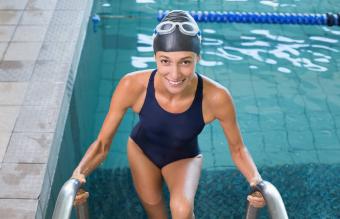
Walking and swimming are both popular forms of exercise that offer a variety of health benefits. Both activities are easy to do, require minimal equipment, and can be done by people of all ages and fitness levels. However, they do have some differences when it comes to the type of workout they provide. Here's what you need to know about walking vs. swimming.
Walking Basics
Walking is a low-impact exercise that can be done anywhere, whether on a treadmill, in a park, on a sidewalk, or even in laps around your home. You can set your own pace and take a break from your day to enjoy the scenery, listen to a podcast or music, or chat with a friend. All you need is a good pair of walking shoes and comfortable clothing.
Walking is easy on the joints and can help to improve cardiovascular fitness, lower blood pressure, and reduce the risk of heart disease and stroke. It is also great for weight loss, reducing stress and anxiety, and benefits your overall well-being.
Walking Tips
If you're new to walking as a form of exercise, here are some tips to help you get started:
- Start slow and easy: If you're not used to regular physical activity, start with short walks at a leisurely pace and gradually increase the duration and intensity over time.
- Wear comfortable shoes: It's important to wear shoes that are supportive and comfortable to help prevent blisters and injuries.
- Dress for the weather: Your clothing should be appropriate for the weather conditions. Sun protection and moisture-wicking fabrics during the hotter months can help protect your skin and keep you cool. Bundle up in layers for colder days.
- Set a goal: Having a specific goal in mind, such as walking for 30 minutes daily, can help you stay motivated and on track.
- Keep good form: Stand up tall, engage your core, and swing your arms naturally while walking.
- Walk at your own pace: It's important to walk at a pace that feels comfortable and sustainable for you, and it's always okay to take a break when you need it.
- Listen to your body: Pay attention to how your body feels, and if you experience any pain or discomfort, stop and rest.
- Find the right environment: Try different walking routes, whether it be in a park, on a sidewalk or trail, to find the environment that you enjoy most.
- Add some variety: To keep things interesting, you can try different walks, such as a brisk walk, a power walk or a hike.
- Find a walking buddy: It's sometimes easier to motivate to get outside when you have someone else holding you accountable.
- Be consistent: Like any other exercise, consistency is key. Make walking a regular part of your daily routine, and you'll see the benefits in no time.
Swimming Basics
Swimming is a full-body workout that provides an excellent cardiovascular workout, strengthening muscles and joints and improving endurance and flexibility. It is also a low-impact form of exercise, which makes it an excellent choice for people with joint problems or injuries. To swim, you'll need a swimsuit, goggles, and a swim cap (if desired) - and access to a pool, of course. If you plan to swim in outdoor lakes, rivers, or oceans, a wetsuit is a good idea.
Swimming has many health benefits - it's a great form of aerobic exercise, which can help to improve cardiovascular fitness and increase endurance and muscle strength. It's also a great way to work on your breathing and relax the mind, thanks to the meditative effect of the rhythm of the strokes. The buoyancy of the water also helps to take pressure off of your joints, which makes it a great option for people with arthritis. It also has been shown to improve flexibility, balance, and coordination.
Swimming Tips
If you're new to swimming and looking to incorporate it into your exercise routine, here are some tips to help you get started:
- Start slow: If you are not used to swimming, start with short sessions and gradually increase the duration and intensity over time.
- Learn the basics: Make sure you know the basic strokes, such as freestyle, backstroke, breaststroke and butterfly, and learn how to get in and out of the pool safely.
- Invest in proper equipment: Make sure you have a properly fitting swimsuit, goggles and a swim cap.
- Focus on good form: Good form will make you swim faster and more efficiently and reduce the risk of injury. Try to keep your body aligned and your kick consistent.
- Take lessons: Swimming lessons can be a great way to improve your technique and increase your confidence in the water.
- Listen to your body: Pay attention to how your body feels, and stop and rest if you feel any pain or discomfort.
- Set a goal: Having a specific goal in mind, such as swimming for 30 minutes daily, can help keep you motivated and feel accomplished when you've reached your goal.
- Mix it up: Experiment with different strokes and lengths of the pool to keep things interesting.
- Consider Additional Equipment: A swimming kickboard is a good exercise tool that you can buy at most sports stores or many online sites. If you tire quickly as you are building up your stamina, a kickboard can help to make you feel more comfortable.
- Practice, practice, practice: The more you swim, the more comfortable and confident you'll become.
- Be consistent: To enjoy the physical and mental health benefits, stick with your swimming workouts, and you'll notice results in time.
Remember that swimming, like any new activity, requires practice to improve. Do not get discouraged if it feels hard initially. You will develop stamina and technique over time.
Weighing Options: Walking vs. Swimming for Exercise
Deciding between walking and swimming for exercise ultimately depends on your needs and preferences. Both forms of exercise offer a variety of health benefits and can be effective for improving cardiovascular fitness, strength, and flexibility.
Consider your individual fitness goals and any physical limitations or injuries you have before deciding. You should also consider the accessibility and availability of facilities, as well as the weather if you plan to swim or walk outdoors. For example, if you live in an area with long, cold winters or hot summers, swimming may be an option only during warmer parts of the year or if your local community center has a pool.
Ultimately, the best form of exercise is the one that you enjoy the most and that you can stick with. Both walking and swimming have great benefits and can be a good form of exercise for overall fitness - it just depends on your preferences and fitness goals.







